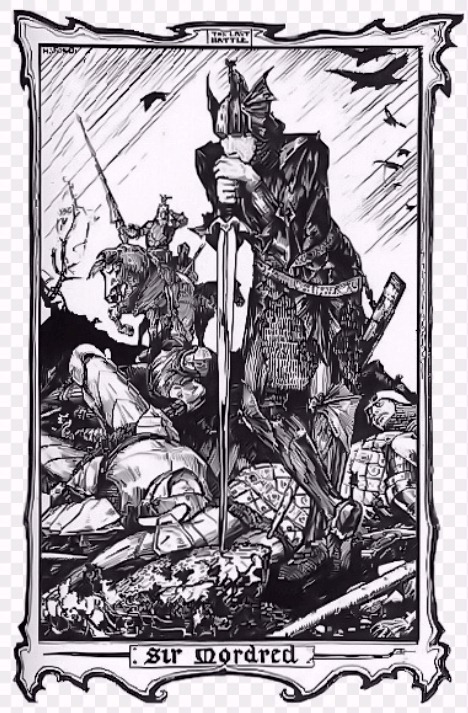LYRICS
More dread
Mordred
The decline of fine
More dread
Mordred
The downfall of all
Traitor narrator
Can’t save your tail
Traitor narrator
Won’t save this tale
Consequences of action
Loss of satisfaction
Collapse of the kingdom
And the woes to come
Lord of societal discord
More dread
Mordred
The demise from rise
More dread
Mordred
The betrayal of all
- Mordred-Part-I.mp3
- Mordred-Part-II.mp3
- Mordred-Part-II-Instrumental.mp3
- Mordred-II-RH-Yamaha-PSR-740.MID
- Mordred-LH-Casio-WK-3500.MID
- Mordred-Pipe-Organ.MID
- Mordred-prequel.MID
Chords: Em Cm Cm Em / A C / G C A / A B C D E F G A / C D E; Part II Blues Ballad Trip-Hop @ 62 Beats Per Minute
Instrumentation: Vocals (TC-Helicon VOICELIVE and MiniNova Vocorder), Keyboards (Korg PS60, Casio WK-3500, Yamaha PSR-740, MiniNova, MicroKorg)
ABOUT MORDRED
Mordred is a key figure in the Arthurian legend, with the earliest mention of a possibly historical Medraut found in the Welsh chronicle Annales Cambriae. This chronicle ambiguously associates Mordred and Arthur with the Battle of Camlann in the year 537. Initially portrayed as Arthur’s treacherous nephew and a legitimate son of King Lot, later versions often depict him as Arthur’s villainous bastard son, conceived through an incestuous relationship with his half-sister, known by various names such as Anna, Orcades, or Morgause, the queen of Lothian or Orkney. The narratives, including those in the Historia and other renditions, culminate in Mordred’s demise at Camlann, typically in a final duel where he manages to inflict a mortal wound upon his own slayer, Arthur.
Mordred’s familial connections, particularly his role as a brother or half-brother to Gawain, remain consistent, while his relationships with Arthur’s wife, Guinevere, exhibit variations. In a popular narrative stemming from 13th-century French chivalric romances and prominently featured in Le Morte d’Arthur, Mordred is knighted by Arthur and becomes a member of the Round Table fellowship. In this version, he emerges as the central figure in Arthur’s downfall, aiding his half-brother Agravain in exposing the affair between Guinevere and Lancelot. Exploiting the resulting civil war, Mordred ascends to become the high king of Britain.
The MORDRED METAPHOR
The legend of Mordred in the Arthurian mythos can be metaphorically linked to the theme of climate change. Mordred’s role as a traitor within the Arthurian legend, contributing to the downfall of Camelot, can be seen as an allegory for the destructive consequences of human actions on the environment.
In the legend, Mordred’s betrayal and manipulation of the circumstances, such as exposing the affair between Guinevere and Lancelot, lead to a civil war and the ultimate collapse of the Arthurian kingdom. This betrayal and the ensuing conflict can be compared to human activities that contribute to environmental degradation, including deforestation, pollution, and unsustainable resource exploitation.
Mordred’s rise to power through exploiting internal conflicts mirrors how environmental issues can intensify due to societal discord and a lack of unified efforts to address climate change. The legend may serve as a cautionary tale, urging humanity to recognize the consequences of its actions on the environment and work together to prevent the potential downfall of the planet.
The metaphorical connection highlights the importance of unity, responsible stewardship of natural resources, and addressing climate change as a collective effort to avoid catastrophic outcomes similar to those witnessed in the legend of Mordred and Camelot.
From the album: Camelot’s Resurgence
A song about The Human Induced Climate Change Experiment
